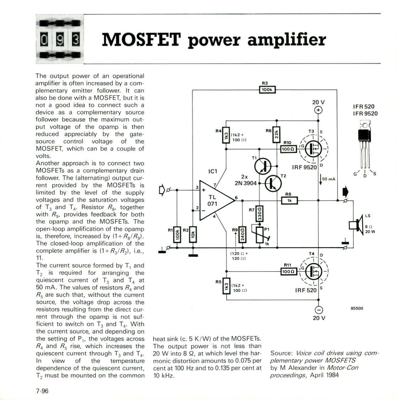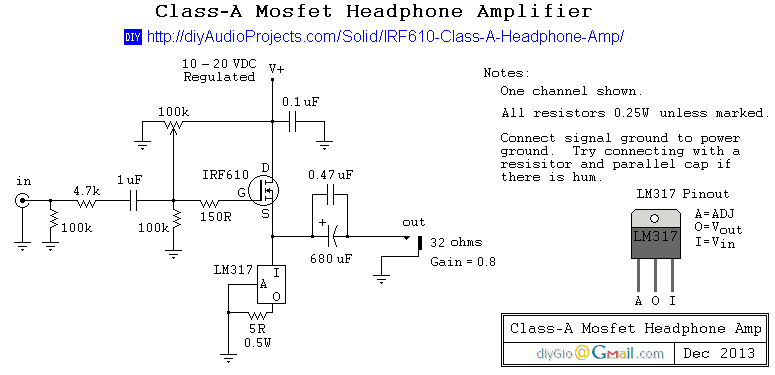Amp Mosfet
Amp Mosfets
Also, when driving a MOSFET like this, it's usual to turn the op-amp into an integrator so that the excessive capacitance of the MOSFET's gate-source does not cause the circuit to become unstable. However, of all the chips that are available, the LM324 is probably one. The MOSFET is an active component that consists of a conductive channel encapsulated between a semiconductor substrate and a metal/oxide structure. We have specially described enhanced NMOS structures that allow a current to pass when the command. Mosfet is a 3 terminal semiconductor device used in a wide range of electronic circuits. It works like a JFET but has less current leakage owing to an oxide insulation between the conductors. Mosfet is a good choice for building linear amplifiers owing to its lesser load, and any amplifier made using it is called a Mosfet amplifier.
Many test with different transistor: MRF186, IRF510,IRF530,MRF9620,IRFZ44N since this kind of kit is able to welcome different mosfet. The final release will be with IRF530 which provide me the best results in terms of linearity,IMD and Harmonics. This amplifier is providing about 20 up to. Shift your audio experience up a gear with the Boss Audio Riot R1100M Class A/B Monoblock Amplifier. This powerful 2-Ohm stable amplifier features 1100 Watts Max Power with a MOSFET power supply to rock your tunes. Customize the sound with Variable Low Pass Crossover and Bass Boost.
In general terms, an amplifier is a device that takes a signal and increases its amplitude. It is part of what is known as an audio playback chain, which typically includes an audio source, such as a CD or record player, and other devices, like pre-amps and equalizers, and ends in a speaker. A MOSFET amplifier is a subcategory of amplifiers that employs metal–oxide–semiconductor field-effect transistor (MOSFET) technology to process digital signals with relatively low power consumption. Once limited to only high-end products, by the early 21st century, MOSFET circuits are the design of choice in more than 99% of microchips manufactured worldwide, including those used in amplifiers.
The idea of using metal-oxide as an insulator in a transistor dates back to the mid-1920s, when the general concept was first proposed and patented in the U.S. by Austro-Hungarian scientist Julius Edgar Lilienfeld. His idea was that metal-oxide layers could control the voltages pushed through a transistor with less of the performance hindrances that plagued existing field-effect transistor (FET) designs. True MOSFET, as it would be recognized today, was developed in the 1960s by Dawon Kahng, who demonstrated the first successful example of an insulated-gate field-effect transistor with gates comprised of metal, oxide, and silicon.

100 Amp Mosfets
Following its transition to the commercial market in the mid-1960s, MOSFET transistors soon found a natural home in amplifier circuits. They replaced the bulkier and more expensive to manufacture vacuum tubes, and surpassed other kinds of insufficient transistors. Also, a stereo or home theater with a MOSFET amplifier generated less heat and used less power than competing technologies, such as bipolar junction transistors (BJTs).

MOSFET transistors came into their own in the digital age. Ideally suited to complementing integrated circuits, the increased demand for them led to lower production costs and widespread adoption into mid- and low-range electronics. Amplifiers that used them found a particular niche in mobile audio, which expanded greatly from the 1980s onward. This industry, by its nature, places significant emphasis on parts generating as little heat and being as small as possible. By enabling the use of relatively powerful amplifiers in dashboard head units, carmakers and aftermarket electronics manufacturers could appeal to audiophiles and justifiably market their products as reasonable mobile alternatives to traditional home theaters.
Marshall Lead 100 Mosfet Amp
In the decades since its introduction, the ubiquity of MOSFET technology in modern circuitry has generally nullified the advantages of using it in marketing copy. Interestingly, it nevertheless remains prevalent in home and mobile audio advertising. Car radios and home theaters still often purport the benefits of MOSFET, despite the fact that it would actually be quite difficult to find an amp on the market built with any other kind of transistors. It is only a slight exaggeration to say that a car stereo advertised on the strength of its MOSFET amplifier is the same as advertising a book on the basis of it being made out of paper.

